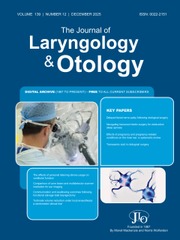Article contents
Role of cervical vestibular evoked myogenic potential response in identifying vestibular dysfunction
Published online by Cambridge University Press: 08 August 2013
Abstract
To analyse cervical vestibular evoked myogenic potential response parameters in normal volunteers and vertiginous patients.
A prospective study of 50 normal subjects and 50 patients with vertigo was conducted at Chiang Mai University Hospital, Thailand. Cervical vestibular evoked myogenic potential responses were measured using air-conducted, 500-Hz, tone-burst stimuli with subjects in a sitting position with their head turned toward the contralateral shoulder.
The mean ± standard deviation age and male:female ratio in the normal (44.0 ± 9.3 years; 12:38) and vertigo groups (44.7 ± 9.8 years; 17:33) were not significantly different. The prevalence of absent responses in the normal (14 per cent) and vertigo ears (46 per cent) differed significantly (p < 0.0001). Other cervical vestibular evoked myogenic potential parameters (i.e. response threshold, P1 and N1 latency, P1–N1 interlatency and interamplitude, inter-ear difference in P1 threshold, and asymmetry ratio) showed no inter-group differences.
The absence of a cervical vestibular evoked myogenic potential response is useful in the identification of vestibular dysfunction. However, patients should undergo a comprehensive battery of other vestibular tests to supplement their cervical vestibular evoked myogenic potential response findings.
- Type
- Main Articles
- Information
- Copyright
- Copyright © JLO (1984) Limited 2013
Footnotes
Presented at the American Academy of Otolaryngology – Head and Neck Surgery Foundation 115th Annual Meeting and Oto Expo, 11–14 September 2011, San Francisco, California, USA
References
- 1
- Cited by


